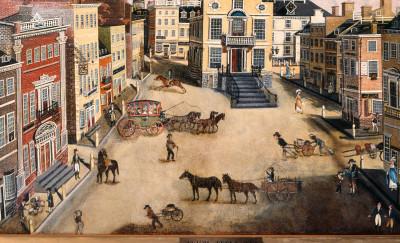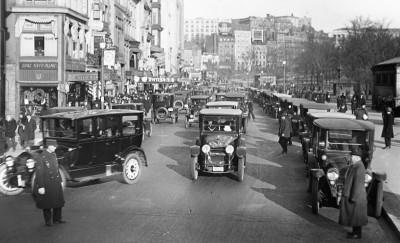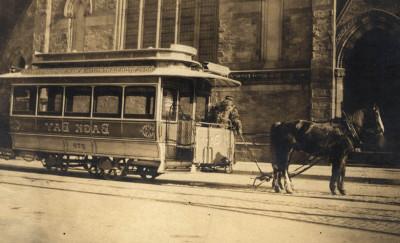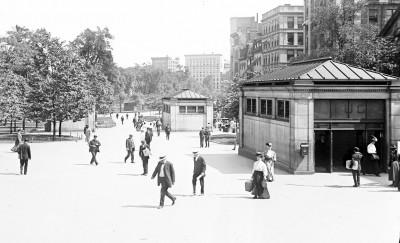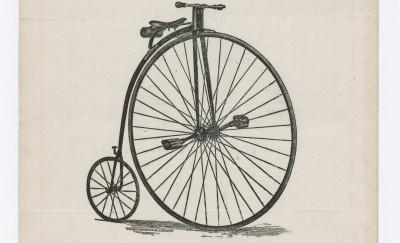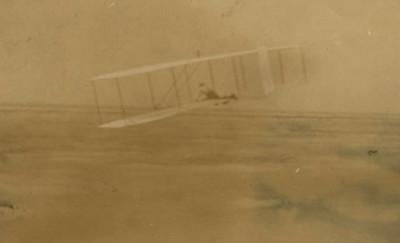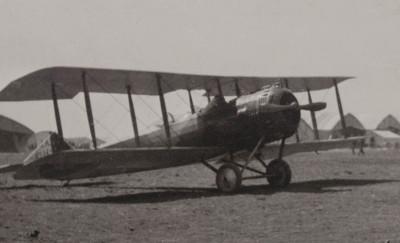Transportation: Change and Continuity
Inquiry Question 1: What is transportation?
Inquiry Question 2: How have methods of transportation changed over time?
Inquiry Question 3: In what ways has transportation changed Boston's streets over time?
Source Set
Download Source Set
Glossary:
Primary source:
a written document, image (picture), or object that help us learn what it was like to live during the time it was created
Transportation:
a system for carrying people or goods from one place to another, using vehicles, roads, and more
Public transportation:
a transportation system provided to all people in an area by a local government
Vehicle:
something that is used for moving people or goods from one place to another
Coach:
a large closed vehicle with four wheels, pulled by horses, used in the past for carrying passengers
Streetcar:
vehicle driven by electricity, that runs on rails along the streets of a town or city and carries passengers. Horses pulled the earliest
Lantern slide:
a type of photograph printed on glass that is made to be shown on a slide projector
Looking at primary sources:
What type of source is this (e.g., painting or photograph)?
Who created it?
When was it created?
Who was its audience?
What was its purpose?
In 1801, James Brown Marston, of Salem, MA, painted this picture showing the eastward side of the Old State House, just a few years after the "new" State House on Beacon Hill became the seat of Massachusetts state government. The open square, a place of social and commercial activity, was the scene of many memorable events, including the Boston Massacre on 5 March 1770.
Students may notice many forms of transportation, including the dirt roads, coaches and horses, people walking and pulling carts. Some people are transporting goods, some are transporting other people, and some are transporting themselves.
Citation: State Street, 1801, Oil on canvas by James Brown Marston, Massachusetts Historical Society, http://twod.ngskmc-eis.net/database/42.
Taken circa the 1920s, this black-and-white photograph depicts Tremont Street, looking northeast from the corner of Boylston St. in Boston, MA. The photograph clearly depicts the boom in car ownership during the decade.
Students can compare this image to a November 2020 Google street view of the same location.
Citation: View of Tremont Street, looking north-east from the corner of Boylston Street, Boston, Lantern slide possibly taken by Arthur A. Shurcliff, circa 1920s, Massachusetts Historical Society, http://twod.ngskmc-eis.net/database/4411.
This 1917 photograph, taken in front of Old South Church on Dartmouth St., depicts the last horse-drawn street car in Boston. You may also want to show students another example of a horse-drawn car from circa 1890.
Horse cars ran on railroad tracks. The first horse car line in Boston began running in 1856, but by the end of the 19th century, streets were clogged with traffic, horses frequently were injured from pulling heavy loads, and it became clear that Boston needed a new public transportation system. In 1888 the first electric streetcar line began operation.
This photograph is also a reminder that new and old technologies have periods of overlap before the old is replaced completely.
Citation: Last horse-drawn streetcar in Boston, 1917, photograph, Massachusetts Historical Society, http://twod.ngskmc-eis.net/database/330.
This photograph, taken at the corner of Tremont and Park Streets in Boston, gives a view of a subway entrance. Boston’s subway system, the nation’s first, began operation in 1897.
The photo also shows a car, people walking, and boys selling newspapers.
Citation: View of subway entrances at corner of Tremont and Park Streets, Boston, Lantern slide possibly taken by Arthur A. Shurcliff, circa 1910s, Massachusetts Historical Society, http://twod.ngskmc-eis.net/database/4479.
Although some version of the bicycle -- velocipedes -- had existed since the early 1800s, pedal powered cycles only became popular after the Civil War. During the 1870s, high-wheel bicycles (sometimes known as “Ordinary” bicycles) became popular. Riders, mainly men, chose how large they wanted their front wheel to be. The largest front wheels went fastest. High-wheel bicycles, however, were dangerous. The rider could fly over the handlebars headfirst if they braked too quickly, or if their front wheel hit an object in the (bumpy) road.
To see boys on and beside their high-wheel bicycles in West Newton, MA in 1886, look at this photo.
Citation: Bicycle Song / Words and Music by Thomas Keith, Boston: Oliver Ditson and Company, 1879, Massachusetts Historical Society, twod.ngskmc-eis.net/database/6489.
This image comes from page four in the 1899 catalog of the Overman Wheel Company. Internationally known, the Overman Wheel Company marketed to both men and women with their Victor and Victoria “safety” bicycles.
The introduction of the so-called "safety bicycle” in the 1890s revolutionized the industry. Easily recognizable as modern bikes, safety bicycles were safer and easier to ride than the high-wheelers that had come before them. Safety bicycles opened cycling to all who could afford the initially high price. By 1890, about 150,000 Americans -- men, women, and children -- owned bicycles. By 1900, millions of Americans owned bicycles.
Citation: Victor Bicycles, MDCCCXCIX, Catalog of the Overman Wheel Co., designed by Will Bradley, Cambridge: University Press, 1899, Massachusetts Historical Society, http://twod.ngskmc-eis.net/database/728.
In October 1903, the engineer Octave Chanute took a series of photographs of the Wright brothers' glider experiments at Kill Devil Hills, North Carolina. The Wrights’ 1902 glider was the first fully controllable aircraft. Two people–each holding onto a different end–ran alongside the glider to help launch it. Lying atop the glider, the pilot used a rudder to steer. The glider remained in the air for only a short time. This is how the glider looked in the air from the side.
On December 17, 1903, only a few weeks after these photos were taken, the Wright brothers flew the first ever engine-powered, heavier-than-air airplane, aptly named the Wright Flyer.
Citation: One of the Wright brothers (unidentified) flying the Wright glider, Outer Banks, North Carolina, 1903, Photograph by Octave Chanute, October 1903, Massachusetts Historical Society, http://twod.ngskmc-eis.net/database/162.
Margaret Hall, a Massachusetts woman and member of the American Red Cross during WWI, took this photograph in Colombey les Belles, a town located in northeastern France, on May 30, 1919. Colombey les Belles was the site of the main aircraft depot and support facility for the U.S. Army air service on the Western Front. By the spring of 1919, U.S. aviation units were being deactivated and sent back to the U.S. from this depot.
The two biplanes seen in the photo appear to be Salmson 2 A.2s, two-seater reconnaissance (designed to carry a camera and take pictures of the ground below) aircraft built by Salmson, a French aircraft engine manufacturer. American aircraft during WWI were known to be dangerous and unreliable. The Salmson 2 A.2s were likely some of the best aircraft that Americans flew during the war.
Citation: "Colombey-la-Belle-- American aviation camp," photograph by Margaret Hall, 30 May 1919, From Letters and Photographs from the Battle Country, typescript narrative by Margaret Hall, Massachusetts Historical Society, http://twod.ngskmc-eis.net/photographs/hall/index.php/view/163/2909.
For Teachers
Transportation: Change and Continuity
Close Reading Questions: Questions to ask about Primary Sources
- Before jumping into the activities, take time to look at each primary source with students. You may want to look at 1-2 images in detail during transition times, or use the images as bell ringers over the course of a week.
- Sourcing: Finding information about primary sources
-
Tell students that all of the sources in the set show different types of transportation -- that is, each source shares images of ways that people got around in Boston, MA in the past.
When you look at each source you can begin by asking them questions, and showing them where to find sourcing information (e.g., date; creator).
- What type of source is this (e.g., painting; photograph; catalog)?
- Who created it?
- When was it created?
- Who was its audience?
- What was its purpose?
- KWL chart
-
Materials:
- Poster paper and marker
- Projector
- Transportation: Change and Continuity sources
Choose any of the primary sources in the set. As a class, you will discuss and ask questions about the image. You may want to preview vocabulary before you start.
- Tell students: This image comes from the past. It gives us information about what Boston / a type of transportation looked like a long time ago.
- Ask students: Take some time to look at this image. What do you think you KNOW about it?
- Ask follow-up questions: How do you know? What information can you see in the picture that tell you this is true?
- Record their responses on the chart.
- Then, ask them: What questions do you have about the image? What do want WANT to know?
- Again, record their responses.
- Finally, read the source description to students. The source description is an information text written by the Mass Historical Society. Ask them: What have you LEARNED about this image?
- Do you still have questions? Where might we look to find answers?
- Close Reading questions for street scenes
-
Primary sources:
Both of these scenes show the city of Boston, MA at different times.
- What is the same about them?
- What is different?
- How do they compare to the city today?
- What are the streets of your town/city like today?
- Close Reading Questions: Vehicles
-
Pair up the sources into twos:
- State St, 1801 and the Horse-pulled Streetcar (mid-1800s - early 1900s)
- The high-wheel bicycle (1870s) and the safety bicycle (1890s)
- The glider (1902) and the WWI airplanes (1919)
Explain that the history of transportation includes many advances, or new changes, in technology for vehicles. For each pair ask:
- What is the same about these two vehicles? How are they different?
- Do we still use this type of vehicle today?
- Why or why not? (It's okay for kids to hypothesize!)
- How have planes / bicycles / public transportation changed (or not) since this image was made?
Suggested Activities
- Geography and Geometry: Position Words (Kindergarten)
-
Materials:
- Transportation: Location and Position Words (Google Slides)
1. Open up the slide deck. In the slides, students will use position words to describe the location of the History Source logo (a red wax seal) to in relation to various objects/people/places in primary source images.
2. Tell students:
- We will look at some paintings and photographs from the past.
3. Model for students how to describe the position of the logo using words like: under, above, over, next to, in front of, left, right, between
- Sentence frame: The logo is _________________ the _________________.
- E.g., The logo is in front of the horse. The logo is under the boy.
4. After modeling, transition to more complex scenes and begin asking students to describe its position. Place the red logo somewhere in the picture. Ask students to describe the location, or position. In the more complex scenes (such as the 1801 State Street painting) there may be multiple correct ways to describe the location of the logo because its position depends on what students use for a point of reference. So, you can ask multiple students to describe the logo's location relative to different objects/people, etc. (e.g., if you place the logo on the steps of the old State house in the State Street painting, students could say "The logo is on top of the stairs" AND "The logo is in front of the building.")
5. You can also ask students to reposition the logo for you.
- Who can move the logo to the left of the boy?
- Who can move the logo between two people?
- Chronology (K-1)
-
Materials:
Directions:
Students should already be familiar with the vehicles in this source set and, generally, when each was invented/put into use.
Students can complete this independently to review what you've already taught.
In the "first, next, then" worksheet, students cut out photos of vehicles in the source set and then glue them in the order each came into use.
In the "Before or After" worksheet students look at photos of the vehicles and then fill-in-the-blank to say if one came into use before or after the other pictured.
- Mapping Places
-
Materials:
- State Street painting (1801)
- Map of State Street (1807)
- rotate counterclockwise
- Mapping Places Google slideshow
Directions:
- Show students State Street painting.
- Point out the yellow building. That is the Old State House.
- Ask students: What else do you notice in this painting?
- Show students the map of State Street.
- Explain: This map was made only 6 years after the painting.
- Ask students to find the Old State House. It is labeled. It is also "A" in the key.
- Show students the key.
- Ask: What else is labeled in the key? Find B, C, and D on the map.
- Use a venn diagram or T-Chart. Compare and contrast the painting and the map.
- What does each one show that the other doesn't?
- Ask: When might you want to use a map of a street?
- Have students draw their own maps of the school or their neighborhood.
- Their maps need to have: a title and a key.
- They should also label other key parts of their maps.
- Extension: Have students use blocks to create a representation of the place in their maps.
- Change and Continuity: City Streets Then vs. Now
-
Materials:
- State Street, 1801 painting
- Tremont St, 1920s photograph
- Google Street View, Tremont St, 2020
- Change Over Time: City Streets Worksheet
- On the Same Streets: 1920 and 2020 Worksheets
Show students two images of Boston: the 1801 painting of State Street and the 1920s photo of Tremont Street. Ask:
- What type of image is each?
- How did the streets change from the 1800s to the 1900s?
- What remained the same?
Next, show students a Google street view image of Tremont and Boylston Streets in Boston from November 2020. It shows the same location as the 1920s photograph. Ask:
- What is different?
- What’s the same?
Have students fill out a t-chart (in worksheet) to take notes on the similarities and differences on the
- Change and Continuity: Pairs of Vehicles
-
Materials:
- Stagecoach in State Street, 1801 painting
- horse-pulled streetcar (1917)
- High-wheel bicycle (1870s)
- Safety bicycle (1890s)
- Wright brothers' glider (1902)
- World War I airplanes (1919)
- Change Over Time: Vehicles Worksheet
Students look at a pair of vehicles to see the similarities and differences between them.
- How did horse-pulled vehicles, bicycles, and aircraft change over time?
- Are they still in use today? In what ways?
- How do modern vehicles look the same/different?
- Fact vs. Opinion (K-2)
-
Materials:
- Fact vs. Opinion GoogleSlides
- Full Bicycle Song lyrics (transcription) and bicycle informational text
- Bicycle Song image and lyrics (original)
Directions:
Define fact and opinion with students (slide 1). You may want to give examples.
-
Fact: a true statement that can be proved with evidence
-
Opinion: someone’s thoughts or feelings about something. They may use evidence to support their opinion, but they may not
Read lyrics to the "Bicycle Song" with students (slide 2).
- Ask students "How does Keith, the songwriter, describe his audience (the person)? How does he describe the high-wheel bicycle? Are these facts or opinions?"
- Students can show thumbs up for "fact" and thumbs down for "opinion".
Read an informational text about high-wheel bicycles (slide 4).
- This informational text tells students more about high-wheel bicycles so that they can better tell if Thomas Keith, the songwriter, was sharing facts about the bicycle, or an opinion.
- Ask, "What does this source tell us about high-wheel bicycles?"
Turn-and-talk: After reading the song lyrics and the non-fiction text tell your partner: Are Keith's lyrics about the high-wheel bicycle being an "easy seat" a fact or opinion?
Discuss or Write: Would you want to learn to ride a high-wheel bicycle? Why/why not?
- Use multiple sources to determine credibility: High-Wheel bicycles (3-5)
-
Materials:
Using multiple sources to determine purpose and accuracy worksheet and documents
Directions:
In this activity, students will look at an image and read Bicycle Song, a song published in Brookline, MA in 1879, about a high-wheel bicycle. This song (or, poem) was written to entertain people about a new type of transportation. Students will then read a short, informational text about high-wheel bicycles and determine whether the claims the author makes in the Bicycle Song are: a) opinion or fact and b) credible or not.
- As a whole class, look at the image of the bicycle on the cover of the sheet music for Bicycle Song.
- Complete the first two columns for a KWL chart. (What do students know? What do they want to know?)
- Before reading the poem, preview any difficult language the students may need to understand the poem.
- Read the Bicycle Song text printed beside the image together as a class.
- Have students determine what other types of transportation the author mentions (walking; riding a coach) and why the author says the bicycle is better (they may point to words like: ‘easy,’ ‘speed’, ‘fun’).
- Then, have students work alone or in pairs to read the informational text “Two Types of Bicycles.”
- Complete the “Learn” column for the KWL chart. What did students learn about the high-wheeler?
- Finally, evaluate the claims made in Bicycle Song. Was the high-wheeler actually an ‘easy seat’?
- Writing: Personal Narratives and Procedural Writing
-
Ideas for student writing:
- Write a personal narrative about one type of transportation that you have used.
- Where were you going? Why did you use that vehicle? What do you like or dislike about it?
- Write a "How-To" book about transportation. It could be: How to ride a bike or scooter; how to get from home to school (or somewhere else); how to travel by bus or subway, etc.
- Make a list. Imagine that you are talking to someone who has traveled to the present day from the past. They have never seen modern vehicles before. Choose one mode of transportation and explain to them how to travel safely & effectively.
- What do you need to: ride a bike/scooter? Travel by car? Travel by bus or subway? Fly on an airplane?
- Write a personal narrative about one type of transportation that you have used.
- Draw It!: Favorite way to get around (K-1)
-
Materials:
What's your favorite way to get around? Make a drawing of it -- be sure to include lots of details, like: location, who you're traveling with, and what the vehicle / mode of transportation looks like.
Then, complete the sentence stem: "My favorite type of transportation is: _____________________."
Applicable Standards
- MA 2018 History and Social Science Framework
-
Practice Standards
Organize information and data from multiple primary and secondary sources.
Analyze the purpose and point of view of each source; distinguish opinion from fact.
Argue or explain conclusions, using valid reasoning and evidence.
Content Standards
Kindergarten Topic 2: Geography: Connections Among Places
Supporting Question: How do maps, globes, and photographs show different things about a place?
1. Describe the location of people, objects, and places, using correctly words and phrases such as up, down, near, far, left, right, straight, back, behind, in front of, next to, between.
Kindergarten, Topic 3: History: Shared Traditions
Put events from their personal lives, observations of the natural world, and from stories and informational texts read or read aloud in temporal order, using words and phrases relating to chronology and time
1st grade, Topic 3: History
Put events from their personal lives, observations of the natural world, and from stories and informational texts read or read aloud in temporal order, using words and phrases relating to chronology and time
- MA English Language Arts Standards
-
- MA Math and English Language Arts Standards
-
Kindergarten, Geometry
Describe objects in the environment using names of shapes, and describe the relative positions of these objects using terms such as above, below, beside, in front of, behind, and next to.
- C3 Framework for Social Studies Standards
-
Grades K-2
D2.His.1.K-2. Create a chronological sequence of multiple events.
D2.His.2.K-2. Compare life in the past to life today.
D2.His.9.K-2. Identify different kinds of historical sources.
D2.His.10.K-2. Explain how historical sources can be used to study the past.
D2.His.12.K-2. Generate questions about a particular historical source as it relates to a particular historical event or development.
Grades 3-5D2.His.1.3-5. Create and use a chronological sequence of related events to compare developments that happened at the same time.
D2.His.2.3-5. Compare life in specific historical time periods to life today.
Additional Resources
Transportation: Change and Continuity
-
Additional Primary Sources at MHS
-
Telegram related to Wrights’ flight
On December 31, 1903 Godfrey Lowell Cabot, a Boston businessman, inventor, and aviation pioneer, sent a telegram to Congressman Henry Cabot Lodge. Cabot told Lodge about the Wright’s flight trials and urged Lodge (and, by extension, the US government) to consider this new technology as having potential for "war-like purposes."
This 1904 photograph, taken by E. I. Whitney of Waltham, Massachusetts, depicts members of the Waltham Cycle Club and their bicycles at Chestnut Hill Reservoir. The Waltham Cycle Club was founded in 1879, at a time when the 'cycling craze' was taking off.
Boston, Mass. Buildings and Street Scenes (circa 1853-1935) collection
The Old State House is depicted in the State Street, 1801 painting in this source set. Additional photos of the Old State House can be seen in the Boston, Mass. Buildings and Street Scenes collection. Students can compare a lantern slide of the Old State House taken between 1853-1900 to two others taken in 1934: one showing the front and the other the Washington Street end. The collection also contains many other photos of the city.
Transcontinental newspaper, 1870
The Trans-Continental newspaper was published in 1870 on the Pullman Hotel Express from Boston to San Francisco, the first American transcontinental charter train. Editor W. R. Steele brought a printing press onboard and printed 12 issues between May and July. The paper's masthead read: "Let Every Step Be an Advance."
The transcontinental railroad was completed and opened for service on May 10, 1869. This image is used in the header of this set.
Boston & Albany passenger train, 1885 (photograph)
Francis Blake, a noted inventor and experimental high-speed photographer, took this photograph of the Boston & Albany passenger train from his estate in Weston, MA in 1885. Today, this location is the intersection of Route 128 and the Massachusetts Turnpike.
Blake's revolutionary high-speed photographs of trains, birds, tennis players, and horseback riders earned him critical acclaim from scientists and artists alike.
Beginning in the 1830s, railroads were built to connect eastern Massachusetts and eastern New York. In 1867, following a merger, the Boston & Albany Railroad Company formed, and remained independent until 1900.
-
Primary sources at other Massachusetts Institutions: Vehicles and places over time
-
Boston and Albany Railroad Company and South Station - (bostonathenaeum.org)
The Boston Athenaeum holds a digitized collection of photographs of the Boston and Albany Railroad Company and the construction of Boston’s South Station in the 1890s.
Collection: Boston and Albany Railroad Company records | HOLLIS for (harvard.edu)
Railroads & Subways Misc. | Flickr (Boston Public Library)
The Boston Pictorial Archie, a photo album from the Boston Public Library, “holds photographs and prints documenting Boston's public transit system in the late-19th and early-20th centuries, with the bulk of the material covering the years from 1897 to 1910. Many of the images offer views of Boston's streetcars, railways, and stations, including images of the recently restored head house at Copley Station.”
Railroads, Elevated -- Massachusetts | Flickr (Boston Public Library)
This photo album from the Boston Public Library contains images of elevated railroads in Massachusetts.
Along the Elevated: Photographs of the Orange Line - Digital Commonwealth
Held at the Boston Public Library, these photos of Boston’s orange line in the 1980s, are shared online at DigitalCommonwealth.
Contents - Boston Transit History and Documents - Research Guides at Boston Public Library (bpl.org)
Boston Public Library published a research guide related to the history of transit in Boston and Massachusetts. It contains links to both primary and secondary sources.
A Snapshot of the Past: Celebrating Worcester’s 300th Anniversary – Past is Present (American Antiquarian Society)
This AAS blog post compares photos of Worcester, MA in 1910 to photos of the same locations around the city today!
Kittie Knox (1874 – 1900) | Mount Auburn Cemetery
Kittie Knox was a competitive cyclist from Massachusetts, and one of few Black women to compete in the sport.
-
Smithsonian Institution: Aircraft and Bicycles
-
The Wright Brothers zz | Inventing a Flying Machine (si.edu)(Smithsonian)
Photos of the Wright glider are part of the MHS collection. Learn more about the Wrights’ journey to create a successful flying machine at this digital exhibit and timeline created by the Smithsonian.
1903 Wright Flyer | National Air and Space Museum (si.edu)
The Smithsonian National Air and Space Museum is home to the 1903 Wright Flyer. The website contains images and a description of the aircraft.
The Wright Brothers & The Invention of the Aerial Age | National Air and Space Museum (si.edu)
The Smithsonian’s National Air and Space Museum has a new exhibit called the Wright Brothers and the Invention of the Aerial Age. By 1909, the Wrights had designed their first military flyer, as described in this Smithsonian Magazine article.
Smithsonian Bicycle Collection | National Museum of American History (si.edu)
This research guide to the Smithsonian’s Bicycle Collection has images of many historic bicycles, and secondary information about them all.
- The Bicycle Craze
-
Marshall W. "Major" Taylor Scrapbooks, 1897-1904 (University of Pittsburgh)
Major Taylor (1878-1932) was a Black professional sprint cyclist, and the fastest man of his day. Born in Indiana, Taylor moved to Massachusetts as a teenager where he competed for teams in Boston and Worcester. Six volumes of Taylor's scrapbooks, spanning 1897-1904, are digitized at the University of Pittsburgh library.
This 1904 photograph, taken by E. I. Whitney of Waltham, Massachusetts, depicts members of the Waltham Cycle Club and their bicycles at Chestnut Hill Reservoir. The Waltham Cycle Club was founded in 1879, at a time when the 'cycling craze' was taking off.
Kittie Knox (1874 – 1900) | Mount Auburn Cemetery
Kittie Knox was a Black competitive cyclist from Massachusetts. Learn more about her life in this blog post from Mount Auburn Cemetery (Cambridge, MA). Mount Auburn dedicated a memorial to her in 2013.
- Additional Worksheets
-
Photograph analysis worksheet for novice learners (National Archives)



